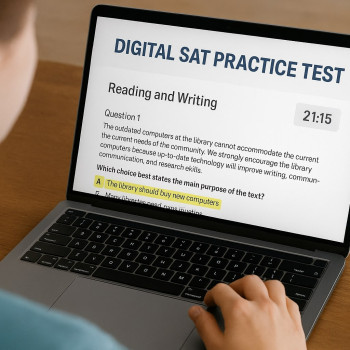Understanding Purdue University’s SAT Expectations: Start Here
If you or your student is planning to apply to Purdue University, you probably have questions: Does Purdue require the SAT? What score should I aim for? How does the Digital SAT fit into the application? Take a breath — this guide walks you through what matters, what doesn’t, and practical steps you can take now to give your application the best chance.

Short answer
Purdue reports an admitted-student SAT range that most applicants use as a benchmark, and they consider SAT/ACT scores as part of admissions. For students aiming to be competitive, think of the SAT range as your target zone rather than a strict cutoff. Importantly, many applicants use SAT scores for scholarships and program placement, so a strategic testing plan still matters.
What the SAT ranges mean (and how to use them)
When colleges publish an SAT range — often the middle 50% of admitted students — they’re showing where most successful applicants fall. For Purdue, that middle 50% typically sits in a specific band that can help you set a realistic and aspirational target.
Interpreting the numbers
- If your SAT is within the middle 50% range, you’re in the competitive pool.
- If you’re above the range, you have a stronger-than-average test profile — but admissions still weigh grades, rigor, essays, and activities.
- If you’re below the range, that doesn’t automatically disqualify you; it just means you should strengthen other parts of your application and consider test re-taking or targeted prep.
Purdue’s practical expectations: What to aim for
Rather than fixating on a single number, think in tiers. Below is a simple framework you can use to translate score ranges into an admissions strategy.
| Score Tier | What it Means | Suggested Actions |
|---|---|---|
| Above the middle 50% | Competitive for admission and scholarships; helps especially for selective majors. | Highlight scores on application; apply for merit-based scholarships; focus on major-specific readiness (e.g., math for engineering). |
| Within the middle 50% | Solid standing — comparable to many admitted students. | Submit scores, emphasize rigor and grade trends; polish essays and recommendations. |
| Below the middle 50% | Admit is possible but review will be holistic; might impact scholarship consideration. | Consider retaking the SAT or submitting optional scores selectively; strengthen coursework, ECs, and personal statement. |
Digital SAT specifics and why they matter for Purdue applicants
The SAT moved to a fully digital format in recent years. The test is shorter overall, but the digital format changes pacing, question types, and the way you interact with the exam. For many students, this is a benefit — the shorter length reduces fatigue, and adaptive testing can help surfaces strengths more accurately — but it also means practice needs to match the new reality.
How to adapt your prep
- Practice on a digital interface: simulating the real exam environment is essential.
- Work on time management: the pacing is different from paper tests, so timing strategies must be revisited.
- Use practice sets that reflect adaptive sections and the question formats you’ll see.
When to submit scores (and when to think twice)
Many students wrestle with whether to submit SAT scores at all. If your score is within or above Purdue’s published middle range, submitting typically strengthens the application. If it’s below, you may still have reasons to submit — for example, if your score is strong in a subject-aligned section relevant to your major or if you think the rest of your application could benefit from a numerical complement.
Questions to ask before you send
- Is my score representative of my academic ability? (If not, consider retaking.)
- Does the rest of my application strongly reflect my readiness and fit for Purdue?
- Am I applying to a program with higher expectations (e.g., certain engineering pathways) that often have stronger applicant profiles?
Putting the SAT into your overall Purdue application strategy
Purdue’s admissions process is holistic: they look at grades, course rigor, essays, recommendations, activities, and test scores. Treat your SAT as one strategic element rather than the whole story.
Concrete steps to strengthen your candidacy
- Keep coursework challenging: admissions value AP, IB, honors, or other advanced classes when available.
- Highlight consistent academic growth — an upward GPA trend can speak loudly.
- Craft essays that show curiosity, resilience, and fit for Purdue’s community and programs.
- Obtain recommendations that speak to both academic ability and character.
How to plan your SAT timeline (digital era)
Timing matters. Give yourself enough runway to learn the digital interface, take practice tests under real conditions, and, if needed, retake the exam before application deadlines.
Suggested timeline for juniors and seniors
- Spring of Junior Year: Start practicing with digital SAT materials; take an initial diagnostic test to identify gaps.
- Summer after Junior Year: Build a focused study plan; target weak areas and simulate full-length digital tests.
- Early Fall of Senior Year: Take a first official Digital SAT (if you’re satisfied with practice progress).
- Later Fall / Early Winter: If needed, retake the SAT to improve your score before typical application deadlines (Early Action and Regular).
Sample study plan: 12 weeks to improvement
This sample plan assumes about 6–8 hours per week of focused work. Modify it based on your baseline diagnostic and goals.
| Weeks | Focus | Weekly Activities |
|---|---|---|
| 1–2 | Diagnostic + Foundation | Take official practice digital SAT; review results; focus on core concepts in weakest areas. |
| 3–6 | Skills Building | Targeted practice sets, timed section work, vocabulary in context, math fundamentals review. |
| 7–9 | Practice Tests | Take one full digital practice test every 7–10 days; review errors deeply and refine timing. |
| 10–11 | Polish & Strategies | Work on elimination strategies, adaptive-test mindset, and endurance; practice weak question types. |
| 12 | Final Prep | Light practice, sleep and routine tuning, test day logistics, and confidence-building review. |
How Sparkl can fit into your Purdue prep (if you want help)
Preparing for the Digital SAT and building a competitive Purdue application can feel like juggling a lot. That’s where personalized support helps. Sparkl’s 1-on-1 guidance can be a game-changer: tailored study plans that align with the Digital SAT format, expert tutors who translate strategy into practice, and AI-driven insights that spotlight the most efficient ways to raise your score. When it fits your needs, Sparkl can help you simulate the test, strengthen weaknesses, and craft a submission plan that complements your academic profile.
When to consider tutoring
- If your diagnostic shows uneven strengths (e.g., great math but weaker evidence-based reading and writing).
- If you balance busy extracurriculars and need a tailored, efficient study plan.
- If you want focused support for program-specific admissions (for instance, engineering majors often benefit from math-focused tutoring).
Major-specific considerations — why scores aren’t the whole story
Certain Purdue programs, especially within engineering, computer science, and technology, often attract applicants with higher test profiles. But even here, demonstrated interest, coursework, projects, and portfolio-like evidence can strongly influence decisions. If you’re leaning toward a competitive major, align your application to show both quantitative readiness (through scores and math courses) and real-world engagement (projects, internships, competitions).
Examples of strengthening a STEM application
- Take calculus, physics, or other advanced courses if available and perform well.
- Showcase research, a capstone, or coding projects with links noted in your application materials (or described in essays).
- Mention relevant competitions, internships, or volunteer experiences that show initiative.
Using SAT scores for scholarships and placement
Beyond admission, SAT scores are often used for scholarship eligibility and course placement. If you’re aiming for merit-based aid, higher scores can make a measurable difference. Similarly, for appropriate placement into honors or advanced courses, test scores can complement your high school transcript.
A quick checklist for maximizing scholarship chances
- Research Purdue scholarship criteria early — many consider SAT/ACT scores as part of eligibility.
- Plan test dates so your best scores arrive before scholarship deadlines.
- Balance test prep with strengthening other scholarship materials such as leadership examples and essays.
What families often forget — and why it matters
Parents and students sometimes focus only on the score number. But admissions officers are human readers: they want context. A score by itself is less persuasive than a narrative showing growth, curiosity, resilience, and fit with Purdue’s opportunities.
Context matters: examples
- A student improved their SAT by 150 points after focused study while taking a full academic load — that trajectory signals discipline and capacity to grow.
- A high-performing student with strong AP results but a modest SAT can offset the number by showing academic consistency and teacher recommendations that highlight classroom mastery.
Realistic next steps you can take this month
If you’re ready to act today, here’s a compact to-do list that balances urgency with realistic effort.
- Take an official digital diagnostic test to set your baseline.
- Map application deadlines for any Purdue programs you care about (Early Action vs. Regular) and set backward milestones.
- Create a targeted 8–12 week study plan emphasizing digital practice and timed sections.
- Consider one-on-one help if you need a focused, efficient improvement plan; personalized tutoring can accelerate progress without adding stress.

Final thoughts — how to think about the SAT and Purdue
At the end of the day, the SAT is a valuable data point, not the whole application. For Purdue applicants, a thoughtful approach is best: know the published score ranges and treat them as targets, practice specifically for the Digital SAT’s format, and make sure your test strategy complements — not competes with — the rest of your application story. If you want personalized guidance, consider targeted tutoring that fits your schedule and goals; tailored plans and one-on-one coaching can be remarkably effective in the digital test era.
A closing pep talk
Applying to Purdue is a meaningful step — it’s normal to feel a mix of excitement and nerves. Keep your focus on steady improvement, tell a coherent story in your application, and use resources wisely. Whether you raise your score a few dozen points or move into a new tier, what matters most is the effort you put in, the way you learn from each practice test, and how honestly you present your strengths. You’ve got this — and if you need help shaping the plan, personalized support from a tutor can keep you calm, efficient, and confident.
Good luck — Purdue is looking for students who are curious, capable, and ready to contribute. Make sure your SAT prep and your application together tell that story.

















No Comments
Leave a comment Cancel